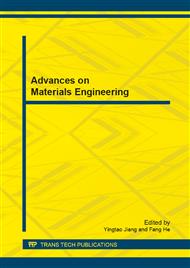p.166
p.173
p.180
p.186
p.191
p.199
p.204
p.209
p.217
The Antimicrobial Effect of Different Antimicrobial Agents on Wood-Plastic Composites
Abstract:
Wood-plastic composites (WPC) were prepared by compression molding process using high density polyethylene and wood fiber as the main raw materials. The influence of nanozinc oxide, nanosilver antimicrobial powder and rosin amid treatment on WPC was investigated respectively by testing the mass loss, flexural strength, color change, surface tension, as well as surface images of the composites before and after the corrosion test. The results indicate that nanozinc oxide has little antimicrobial effect on WPC. While nanosilver antimicrobial powder and rosin amid both have effects on the anti-corrosion properties of WPC. It is also suggested that the WPC with the mass fraction of 6% rosin amid is the most antimicrobial, and its mass loss and flexural strength only decrease by 0.0788% and 2.24% respectively. These cost-efficient WPC can be practical to industrial application.
Info:
Periodical:
Pages:
191-196
Citation:
Online since:
August 2013
Authors:
Price:
Сopyright:
© 2013 Trans Tech Publications Ltd. All Rights Reserved
Share:
Citation:


